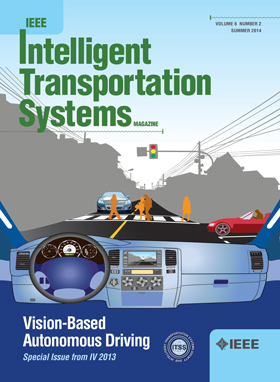基于双信息物理网络的车联网云形成优化
IF 8.4
1区 工程技术
Q1 ENGINEERING, CIVIL
IEEE Transactions on Intelligent Transportation Systems
Pub Date : 2025-04-10
DOI:10.1109/TITS.2025.3554847
引用次数: 0
摘要
车辆云(vehicle cloudlet, VC)将在车联网(IoV)中采用,能够利用协同效应支持新兴的协同服务和相邻车辆之间的任务卸载。与传统基于链路连通性的聚类方法相比,vc对传输容量和稳定性的要求更高。在优化构建风险投资结构时,必须解决三个主要挑战。首先,传输容量受到固有的随机特性的影响,包括信道衰落和干扰。其次,车辆的移动性带来了不稳定性。第三,需要综合优化模型,共同提高已建立VC的稳定性和传输能力。为此,本文提出了一种双信息物理网络(DCP)模型来表示动态物理网络和耦合传输网络。基于Nakagami-m小尺度衰落模型,导出了信道质量的广义解析表达式。在此基础上,提出了考虑物理拓扑稳定性和信道传输容量的DCP关联密度优化模型。采用对称非负矩阵分解来解决低复杂度的优化问题。仿真结果表明,与现有的基于链路连通性的聚类方法相比,该方法具有更高的传输容量和稳定性。本文章由计算机程序翻译,如有差异,请以英文原文为准。
Dual Cyber-Physical Network-Based Optimization of Cloudlet Formation for the Internet of Vehicles
The vehicular cloudlet (VC), capable of leveraging synergies to support emerging cooperative services and task offloading among neighboring vehicles, will be adopted in the Internet of Vehicles (IoV). Compared with traditional clustering methods based on link connectivity, VCs require higher transmission capacity and stability. Three major challenges must be addressed when optimally establishing the VC structure. First, the transmission capacity is affected by inherent stochastic characteristics, including channel fading and interference. Second, the mobility of vehicles introduces instability. Third, a comprehensive optimization model is required to jointly improve the stability and transmission capacity of the established VC. Therefore, this paper proposes a dual cyber-physical network (DCP) model to represent the dynamic physical network and the coupled transmission network. Generalized analytical expressions for channel quality are derived using moment-generating functions based on a Nakagami-m small-scale fading model to handle stochastic characteristics. Furthermore, a DCP association density optimization model is proposed that considers the stability of the physical topology and the transmission capacity of the channel. Symmetric non-negative matrix factorization is used to solve the optimization problem with low complexity. Simulation results confirm that our proposed method achieves higher transmission capacity and stability compared existing link connectivity-based clustering methods.
求助全文
通过发布文献求助,成功后即可免费获取论文全文。
去求助
来源期刊

IEEE Transactions on Intelligent Transportation Systems
工程技术-工程:电子与电气
CiteScore
14.80
自引率
12.90%
发文量
1872
审稿时长
7.5 months
期刊介绍:
The theoretical, experimental and operational aspects of electrical and electronics engineering and information technologies as applied to Intelligent Transportation Systems (ITS). Intelligent Transportation Systems are defined as those systems utilizing synergistic technologies and systems engineering concepts to develop and improve transportation systems of all kinds. The scope of this interdisciplinary activity includes the promotion, consolidation and coordination of ITS technical activities among IEEE entities, and providing a focus for cooperative activities, both internally and externally.
 求助内容:
求助内容: 应助结果提醒方式:
应助结果提醒方式:


